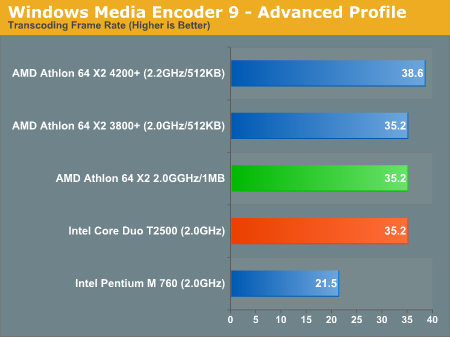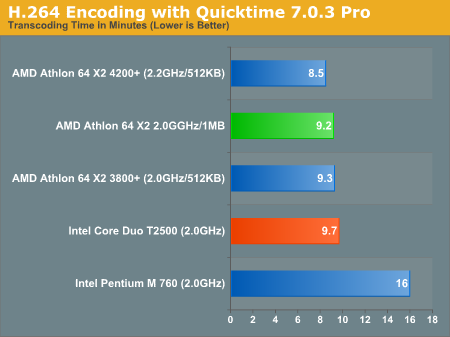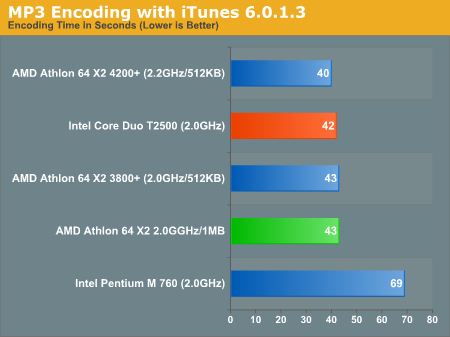Intel Core Duo (Yonah) Performance Preview - Part II
by Anand Lal Shimpi on December 19, 2005 12:55 PM EST- Posted in
- CPUs
Media Encoding Performance with DVD Shrink, WME, Quicktime and iTunes
We were most curious about the Core Duo's media encoding performance, given that a number of the optimizations for the new processor were FP/SSE related. We've updated our entire media encoding test suite, including everything from the one-click DVD ripping utility DVD Shrink to including H.264 encoding performance with Quicktime 7.0.3 Pro. We wanted to include the latest version of DivX in this comparison. However, the recent release of DivX 6.1 left us with a few bugs that we're still trying to work out in our test beds, so we had to exclude it. However, as time goes on, H.264 encoding will quickly become far more important than even looking at DivX, so its omission from this article isn't as big of a loss in terms of forward-looking performance.
First up is DVD Shrink 3.2.0.15. Our test was simple - we took a copy of Star Wars Episode VI and ripped the full DVD to the hard drive without compression, effectively giving us an exact copy of the disc on the hard drive. Then, using the copy of the DVD on the hard drive (to eliminate any DVD drive bottlenecks), we performed a DVD shrink operation to shrink the movie to fit on a single 4.5GB DVD disc. All of the options were left on their defaults, so the test ends up being pretty easy to run and reproduce. The scores reported are DVD encoding times in minutes, with lower numbers meaning better performance.
The DVD Shrink test is quite important as DVD Shrink is quite possibly one of the easiest tools to rip a DVD. The easier a tool is to use, the more likely it's going to be used, and arguably the more important performance using it happens to be.
Moving on, we have our Windows Media Encoder 9 test, which uses the advanced profile settings for video encoding. We left all settings at their defaults and just proceeded with a MPEG-2 to WMV-HD conversion. The values reported are in frames per second, with higher numbers being better.
Next up, we have Quicktime Pro 7.0.3 and we perform a MPEG-2 to H.264 encoding task. All of the settings are left at their defaults, with the exception that we optimize the output file for download with a 256kbps data rate while leaving the resolution untouched. We also adjust the video options to optimize for the best quality. We report the transcoding time in minutes, with lower values being better.
Finally, we have a MP3 encoding test using iTunes 6.0.1.3. For this test, we simply took a 304MB wav file and converted it to a 192kbps MP3 file, measuring the encode time in seconds. The only iTunes option that we changed was to prevent the playback of the song while encoding.
We were most curious about the Core Duo's media encoding performance, given that a number of the optimizations for the new processor were FP/SSE related. We've updated our entire media encoding test suite, including everything from the one-click DVD ripping utility DVD Shrink to including H.264 encoding performance with Quicktime 7.0.3 Pro. We wanted to include the latest version of DivX in this comparison. However, the recent release of DivX 6.1 left us with a few bugs that we're still trying to work out in our test beds, so we had to exclude it. However, as time goes on, H.264 encoding will quickly become far more important than even looking at DivX, so its omission from this article isn't as big of a loss in terms of forward-looking performance.
First up is DVD Shrink 3.2.0.15. Our test was simple - we took a copy of Star Wars Episode VI and ripped the full DVD to the hard drive without compression, effectively giving us an exact copy of the disc on the hard drive. Then, using the copy of the DVD on the hard drive (to eliminate any DVD drive bottlenecks), we performed a DVD shrink operation to shrink the movie to fit on a single 4.5GB DVD disc. All of the options were left on their defaults, so the test ends up being pretty easy to run and reproduce. The scores reported are DVD encoding times in minutes, with lower numbers meaning better performance.
The DVD Shrink test is quite important as DVD Shrink is quite possibly one of the easiest tools to rip a DVD. The easier a tool is to use, the more likely it's going to be used, and arguably the more important performance using it happens to be.

- The Pentium M performs exceptionally poorly, and
- The Core Duo performs exceptionally well.
Moving on, we have our Windows Media Encoder 9 test, which uses the advanced profile settings for video encoding. We left all settings at their defaults and just proceeded with a MPEG-2 to WMV-HD conversion. The values reported are in frames per second, with higher numbers being better.

Next up, we have Quicktime Pro 7.0.3 and we perform a MPEG-2 to H.264 encoding task. All of the settings are left at their defaults, with the exception that we optimize the output file for download with a 256kbps data rate while leaving the resolution untouched. We also adjust the video options to optimize for the best quality. We report the transcoding time in minutes, with lower values being better.

Finally, we have a MP3 encoding test using iTunes 6.0.1.3. For this test, we simply took a 304MB wav file and converted it to a 192kbps MP3 file, measuring the encode time in seconds. The only iTunes option that we changed was to prevent the playback of the song while encoding.

Professional Application Performance with 3dsmax, Adobe Premier and Photoshop
Gaming Performance with Battlefield 2 and Black & White 2










103 Comments
View All Comments
Shintai - Monday, December 19, 2005 - link
I doubt a a laptop uses 108W and got a x800XT. That powerchart is close to useless.A Core Duo laptop is 31 peak for CPU and 2.5 for the 945GM. A single core tution is 35W. unless you want 25W part, but then we gotta use the lower intel part aswell.
Dualcore Turion wont even stand a chance until it get 65nm.
Furen - Tuesday, December 20, 2005 - link
The 25W Turion parts are $5 more expensive than the 35W parts, hardly comparable with the price difference between regular and LV Intel CPUs. I agree with you in that I dont expect 90nm Turions to match Yonah's power consumption but I must say that what I've heard about the Yamato platform (which, to tell the truth, is almost nothing) makes me think that it'll be a closer match than we think.Missing Ghost - Monday, December 19, 2005 - link
What, no 64 bit?I won't buy this.
fitten - Tuesday, December 20, 2005 - link
Do you actually use 64-bit or is it just a feature checkbox? I bought some Athlon64s because they were 64-bit and allowed me to test the software I write on a 64-bit platform, for example... not that the codes I actually write require many of the features of 64-bit, though. In the past, I have written and worked on a number of projects that actually need 64-bit (typically just very large datasets which can just be used flat in 64-bit as opposed to all sorts of tiling and paging on a 32-bit machine).Chickan - Monday, December 19, 2005 - link
Did anyone else notice that the numbers in the graph for Black and White did not match up with the spreadsheet below it? According to the graph, the Core Duo hit 44.5 FPS, the same as the X2 2ghz w/ 1mbx2, but in the sheet below, it is reported to only do 40.1 FPS, lower than even the Pentium M. In fact, it performs the worst out of all the CPU's there, at every resolution, even though this is not reported, nor mentioned.I also find it interesting that Intel's new line is only able to match X2's, not beat them. Either way, lets see some new stuff from AMD!
KazenoKoe - Monday, December 19, 2005 - link
Odd, the article clearly has it at 42.3fps on both the graph and the table. The Pentium M got 40.1 and the X2 2GHz/1MB got 44.5.WitchKing - Monday, December 19, 2005 - link
I enjoyed reading this 2nd article on the next Intel platform.Although I am basically in favor of AMD since Athlon platform, I am quite glad that Intel is closing the performance gap. It will make AMD move further ;-)
Anyway, it should be quite interesting to see how these 2 platforms compare in 64-bits tasks (Windows XP-64, Vista (is a 64-bits version available yet?) and linux based).
A 3rd opus of this article maybe? ;-)
saratoga - Monday, December 19, 2005 - link
Yonah does not support x86-64, so doing 64 bit testing is not possible.phaxmohdem - Monday, December 19, 2005 - link
I thought this review was much better than the first. Thanks guys. It pretty much illustrates the same thing, but it is interesting to read about new CPU's none the less.I don't mind the name personally, I think that we uber-nerds don't like it because we actually know what a core is in regards to a CPU. Your typical idiot customer doesn't know what a Core, or Processor die is, and Core is just another brand name like Pentium.
While these chips look freaking awesome for laptop use, I must admit I will ver very dissapointed it Conroe launches, and only brings Intel back to equality with AMD. When a new generation of CPU launches, I generally like to think that they are releaseing something to regain their status as performance leader, not just level the playing field. (Though I guess PII/PIII/P4 al launched with worse performance than the high end of their predecessors)
tfranzese - Monday, December 19, 2005 - link
If memory serves, the only one to launch with a loss in performance was the Pentium 4. The Pentium II was a great advancement over the Pentium it replaced (not the Pro) and the Pentium III performed equally, though was available at higher clock speeds. That said, I don't know where you got to grouping the PII and PIII in with the P4's poor launch status. Willamette was a joke.